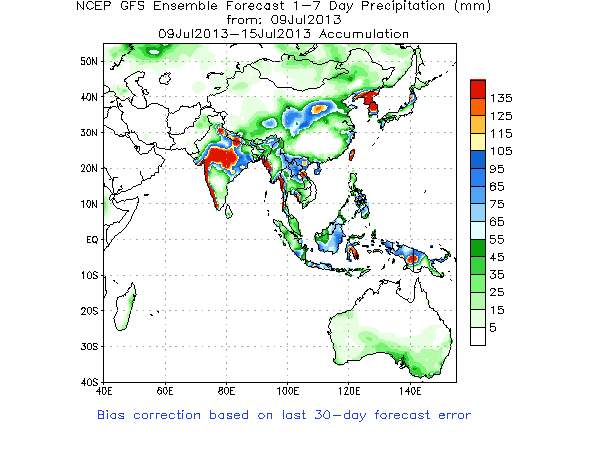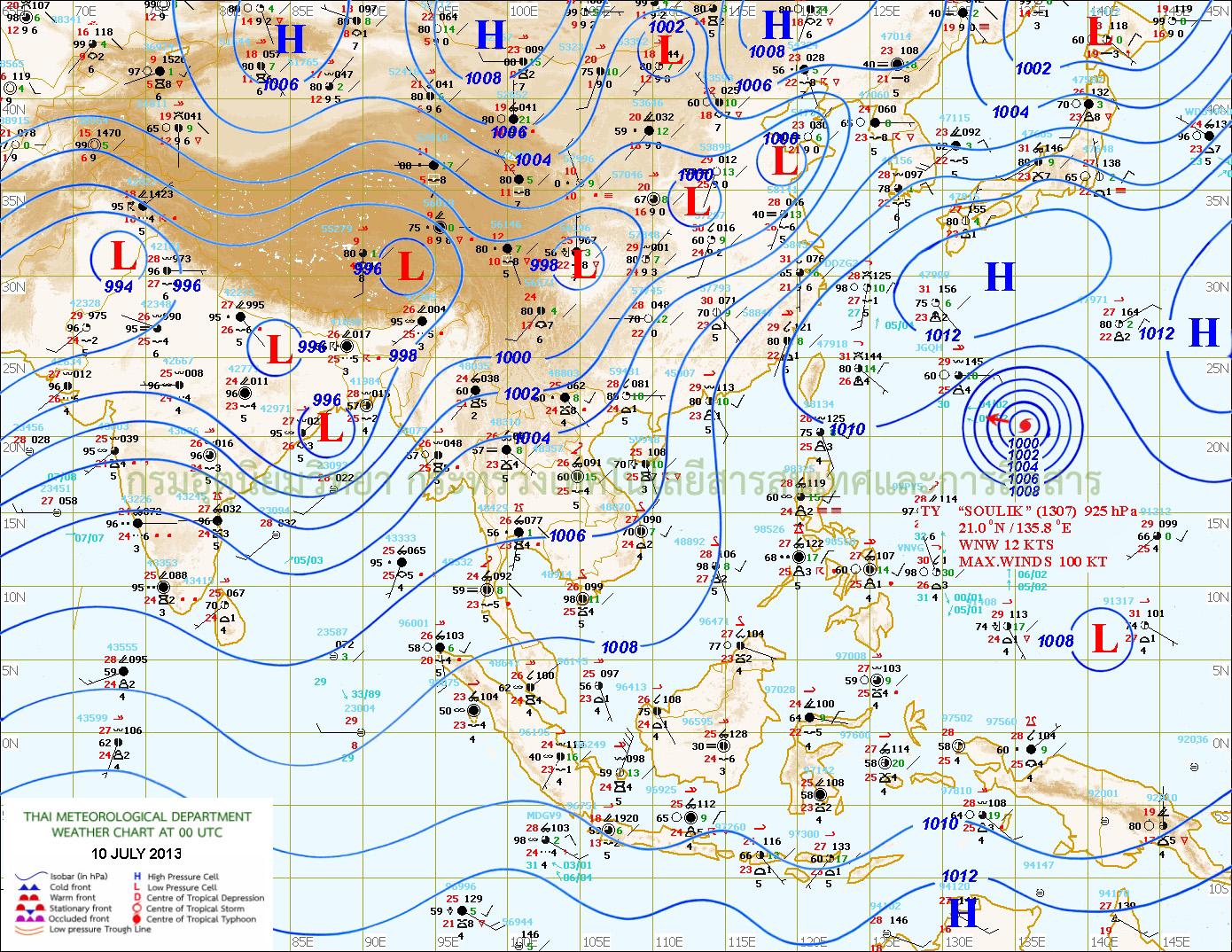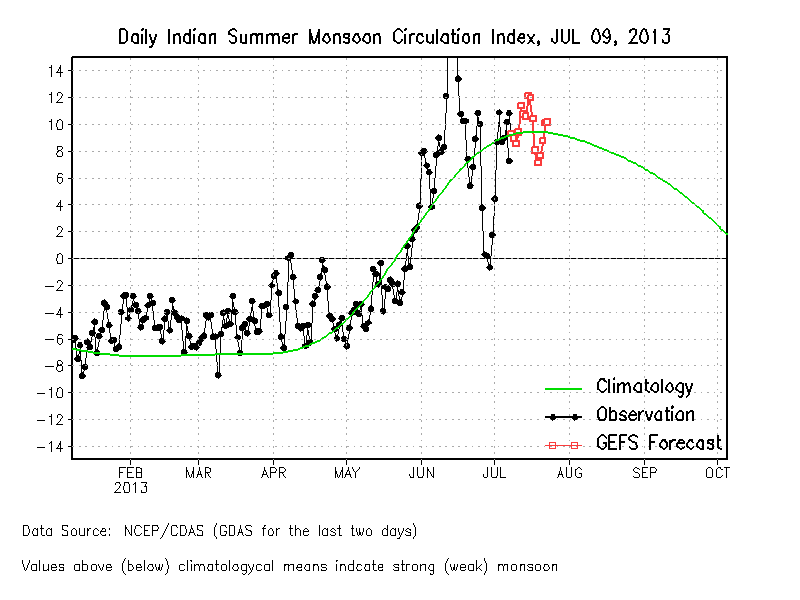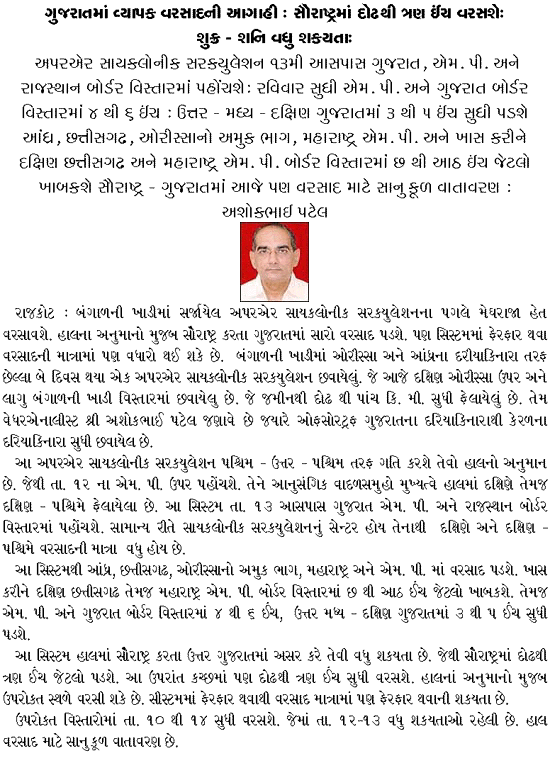Current Weather Conditions on 10th July 2013 @ 2.00 pm.
An Upper air Cyclonic Circulation has persisted for last two days over Northwest Bay of Bengal near the Coastal areas of Odisha and vicinity. This Upper Air Cyclonic Circulation was located over Odisha and adjoining Northwest Bay of Bengal this morning and has subsequently developed to a Low Pressure located over the same region of Coastal Odisha and adjoining Northwest Bay of Bengal.
The axis of monsoon trough at mean sea level passes through Ferozepur, Delhi, Fursatgunj, Daltongunj, Keonjergarh to Center of Low Pressure area and thence Southeastwards to Eastcentral Bay of Bengal.
The offshore monsoon trough runs from Gujarat coast to North Kerala.
TMD Weather Chart of 10th July 00 UTC shows the Low Pressure Area
The NCEP weekly precipitation map shows heavy rainfall areas over Central India including Madhya Pradesh and vicinity. Also heavy rainfall area is shown for West coast of India. Saurashtra has both light as well as medium and heavy rainfall for period ending 15th July. North Gujarat shows medium rainfall.
 Daily Monsoon Index chart shows that the Monsoon will be near normal for the next two weeks for India with Monsoon Index fluctuating between 7 to 12 with an average between 9 to 10. This is encouraging for the performance of Monsoon.
Daily Monsoon Index chart shows that the Monsoon will be near normal for the next two weeks for India with Monsoon Index fluctuating between 7 to 12 with an average between 9 to 10. This is encouraging for the performance of Monsoon.



શ્રીમાન અશોકભાઇ
આપની આગાહી મુજબ રાજકોટમા આજે સવારે વરસાદ હતો. વરસાદ કેટલા સમય સુધી ચાલુ રહેવાની સ્ભાવના છે.
જનરલ સૌરાષ્ટ્ર ગુજરાત અને કચ્છ માટે વાતાવરણ સારું રહેશે તારીખ ૧૨ થી ૧૪ સુધી.
Sir, most of times bob system travel northwestwardly which benefit central-north gujarat mostly. Which direction benefit saurashtra? Is any time in past bob system gave very heavy rain in saurashtra?
Many times BOB System has given good rainfall for Saurashtra. The rain increases due to moisture incursion from Arabian Sea and also due to strengthening of off-shore trough when the BOB system approaches near Saurashtra/Gujarat.
Sir, Relatively still the quantum of rain over Saurashtra this year is much lesser compared to rest of Gujarat. Only rain has been here due to the cyclonic circulation around 7-15 June hovering over the region. also most of the system generating from BoB tracks towards Central North gujarat and moves towards south Rajasthan rather moving over towards Saurashtra. This particular system also seems to track towards same direction like the last one last week. Also sir one more observation is that the axis of monsoon is in north india since so long, not moving southern. What are possibilities of… Read more »
Comparison can be done in terms of average yearly rainfall of Saurashtra and say South Gujarat or North Gujarat or East Central Gujarat. Current position as of 11th July morning 8.30 am. is as under: Saurashtra yearly average rainfall (30 years 1982-2012) is 642 mm. Received 299 mm. or 47 % South Gujarat yearly average rainfall (30 years 1982-2012) is 1359 mm. Received 516 mm. or 38 % East Central Gujarat yearly average rainfall (30 years 1982-2012) is 811 mm. Received 288 mm. or 36 % North Gujarat yearly average rainfall (30 years 1982-2012) is 667 mm. Received 228 mm.… Read more »
Dear: sir
Aape aapela aa javab ne gujarati
Janavso to mare jeva mitro pan samji sake
Thenk u sir..
હવામાન માટે નું મહત્તમ સાહિત્ય અંગ્રેજી માં છે એટલે કા અંગ્રેજી સીખો અથવા કોઈ મિત્રો ની મદદ લઇ ને સમજો કારણ કે હું બધી પોસ્ટ ગુજરાતી માં સમજાવી ના શકું.
Dear Ashokbhai,
I am a regular visitor of your wonderful and scientifically informative web site and have slowly started developing interest in meteorology. It is fascinating to learn mother nature. Whenever i read news of a low developing over BoB, the one question that always pops in my mind is why such a low hardly develops in arabian sea adjacent to saurashtra coast? Such type of low might bring good rains over the region. Is not so? Do reply. Thanks.
Girirajsinh, North Indian Ocean is divided into two areas by India: the Bay of Bengal and the Arabian Sea, with the Bay of Bengal dominating (5 to 6 times more activity). Still, this basin is the most inactive worldwide, with only 4 to 6 storms per year. This basin’s season has a double peak: one in April and May, before the onset of the monsoon, and another in October and November, just after monsoon. Although it is an inactive basin, the deadliest tropical cyclones in the world have formed here, including the 1970 Bhola cyclone, which killed 500,000 people. Nations… Read more »